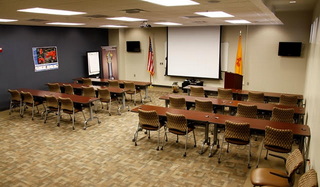Training Solutions
 Audio-visual (AV) aids are invaluable in training due to their ability to engage, inform, and facilitate effective learning experiences. Here are the uses and importance of AV in training across various industries:
Audio-visual (AV) aids are invaluable in training due to their ability to engage, inform, and facilitate effective learning experiences. Here are the uses and importance of AV in training across various industries:
- Enhanced Learning Experience: AV technology provides a multi-sensory learning experience that engages auditory and visual senses simultaneously. This engagement aids in better information retention and understanding of complex topics.
- Accessibility and Flexibility: AV content can be accessed remotely, allowing trainees to learn at their own pace and convenience. This flexibility is especially useful for distributed teams, remote employees, or individuals with varied schedules.
- Improved Retention and Comprehension: Visual aids, videos, animations, and interactive presentations in training materials help learners grasp concepts more effectively, leading to better retention of information.
- Demonstration of Procedures and Techniques: AV technology allows for the creation of instructional videos demonstrating procedures, processes, and techniques. This visual demonstration enhances comprehension and ensures consistent training across learners.
- Cost-Effectiveness: AV technology reduces the need for in-person trainers and printed materials, thereby saving costs associated with traditional training methods. It also enables training materials to be reused or updated easily.
- Realistic Simulations and Scenarios: Simulations, augmented reality (AR), or virtual reality (VR) experiences through AV technology provide a safe environment for trainees to practice real-life scenarios, improving their skills and decision-making abilities.
- Consistency in Training: AV content ensures consistency in training delivery. All trainees receive the same quality of instruction and information, eliminating variations that might occur with manual training methods.
- Feedback and Assessment: AV technology enables the incorporation of quizzes, interactive exercises, and assessments into training modules, providing immediate feedback to trainees and allowing trainers to assess learning outcomes more effectively.
- Language and Cultural Adaptation: AV technology allows for training content to be translated into different languages and adapted to various cultural contexts, making it accessible and relatable to diverse audiences.
- Compliance and Regulatory Training: AV technology aids in delivering compliance and regulatory training by providing engaging content that explains complex regulations, ensuring employees understand and adhere to necessary guidelines.
- Onboarding and Continuous Learning: AV technology supports onboarding processes by delivering comprehensive training materials to new hires and enables continuous learning through easily accessible resources.
In summary, the use of AV technology in training offers engaging, effective, and flexible learning experiences, catering to different learning styles while improving retention, comprehension, and the overall effectiveness of training programs across industries.
